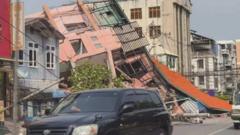The impact of a powerful earthquake in Myanmar has resulted in over a thousand deaths, widespread damage, and challenging rescue operations amidst media restrictions.
**Myanmar Earthquake: A Tragedy Unfolds Amidst Chaos**

**Myanmar Earthquake: A Tragedy Unfolds Amidst Chaos**
An overview of the devastating earthquake that struck Myanmar and its profound consequences.
A significant earthquake measuring 7.7 on the Richter scale struck central Myanmar recently, with tremors felt across borders, including Thailand and parts of southwest China. Reports confirm over 1,000 fatalities and upwards of 2,000 injuries, although accurate data is hard to ascertain due to communication challenges.
The quake's epicenter was located approximately 16 kilometers northwest of Sagaing, close to the densely populated city of Mandalay, which has around 1.5 million residents. The initial earthquake occurred at 12:50 local time, followed by another tremor measuring 6.4 within 12 minutes. The aftermath has seen severe structural damage, including ruptured roadways in the capital and other regions.
Several construction workers are missing following the collapse of an incomplete high-rise in Bangkok, which is distanced from the quake's epicenter, suggesting the extensive reach of the tremors. Witnesses reported chaotic scenes, including a rooftop swimming pool spilling over due to the building's movement.
The military reported a death toll of 1,002, largely concentrated in Mandalay. Rescue operations are ongoing, with teams working tirelessly to reach those trapped under debris in challenging conditions. Concerns about information accessibility within Myanmar also hinder the efforts; the country has been under military rule since 2021, leading to media censorship and limited communications post-disaster.
With a threat of aftershocks looming, travel advisories have been issued by the UK's Foreign, Commonwealth & Development Office, cautioning against unnecessary journeys to affected areas. They also highlighted that Myanmar's security situation remains unpredictable, influencing travel discussions regarding neighboring Thailand and Laos.
Seismologists explain that the earthquake's relatively shallow depth of about 10 kilometers increases the likelihood of severe surface damage. Comparisons are drawn to past quakes, including the catastrophic 2004 Indonesian earthquake that resulted in over 228,000 casualties and the historic 9.5 magnitude quake in Chile in 1960.
As Myanmar grapples with this natural disaster on top of existing humanitarian challenges, the need for aid and support is increasingly urgent while the world watches closely.





















